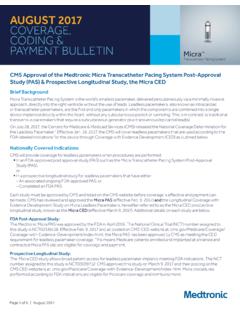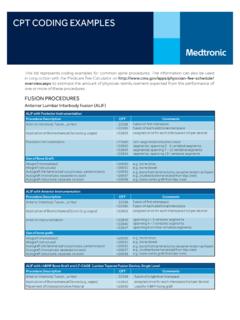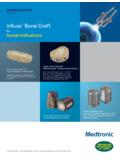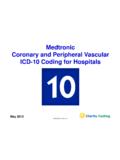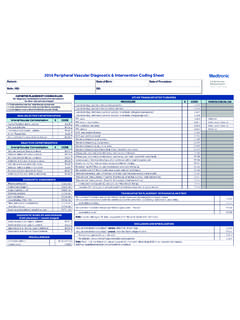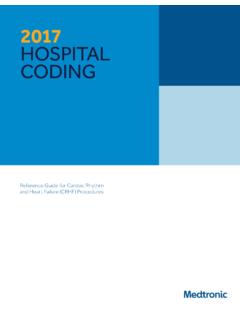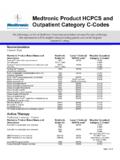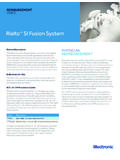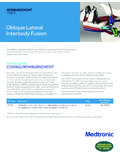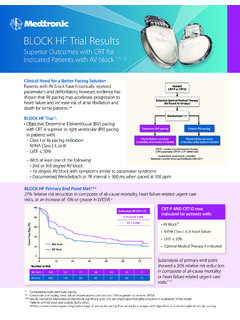Transcription of COMMONLY BILLED CODES - medtronic.com
1 UC201002977oEN COMMONLY BILLED CODES SACRAL NEUROMODULATION FOR BLADDER CONTROL OR BOWEL CONTROL EFFECTIVE JANUARY 2018 UC201002977oEN 2 medtronic provides this information for your convenience only. It does not constitute legal advice or a recommendation regarding clinical practice. Information provided is gathered from third-party sources and is subject to change without notice due to frequently changing laws, rules and regulations. medtronic makes no guarantee that the use of this information will prevent differences of opinion or disputes with Medicare or other payers as to the correct form of billing or the amount that will be paid to providers of service. Please contact your Medicare contractor, other payers, reimbursement specialists and/or legal counsel for interpretation of coding, coverage and payment policies.
2 This document provides assistance for FDA approved or cleared indications. Where reimbursement is sought for use of a product that may be inconsistent with, or not expressly specified in, the FDA cleared or approved labeling (eg, instructions for use, operator s manual or package insert), consult with your billing advisors or payers on handling such billing issues. Some payers may have policies that make it inappropriate to submit claims for such items or related service. The following information is calculated per the footnotes included and does not take into effect Medicare payment reductions resulting from sequestration associated with the Budget Control Act of 2011. Sequestration reductions went into effect on April 1, 2013. ICD-10-CM1 Diagnosis CODES Diagnosis CODES are used by both physicians and hospitals to document the indication for the procedure.
3 InterStim Therapy is used for Bowel Control and Bladder Control. InterStim Therapy for Bowel Control is directed at addressing the symptom of chronic fecal incontinence. InterStim Therapy for Bladder Control is directed at addressing specific urinary symptoms. Symptom CODES are assigned as the principal diagnosis when the underlying cause is not known or not documented. However, if the underlying cause is known, then the cause is sequenced as the principal diagnosis and fecal incontinence or the urinary symptom is assigned as a secondary code. Bladder Control Urinary Symptoms Urge incontinence Other retention or urine Retention of urine, unspecified Frequency of micturition Feeling of incomplete bladder emptying Bowel Control Fecal incontinence Full incontinence of feces FOR QUESTIONS PLEASE CONTACT US AT SACRAL NEUROMODULATION COMMONLY BILLED CODES Chart continued on next page UC201002977oEN 3 SACRAL NEUROMODULATION COMMONLY BILLED CODES ICD-10-CM1 Diagnosis CODES continued Other Diagnoses (Bladder Control and Bowel Control) Device Complications2, 3 Breakdown (mechanical) of implanted electronic neurostimulator of peripheral nerve electrode (lead)4 Breakdown (mechanical)
4 Of implanted electronic neurostimulator, Displacement of implanted electronic neurostimulator of peripheral nerve electrode (lead)4 Displacement of implanted electronic neurostimulator, generator Other mechanical complication of implanted electronic neurostimulator of peripheral nerve electrode (lead)4 Other mechanical complication of implanted electronic neurostimulator, generator Infection and inflammatory reaction due to implanted electronic neurostimulator of peripheral nerve, electrode (lead)4 Infection and inflammatory reaction due to implanted electronic neurostimulator, generator Hemorrhage due to nervous system prosthetic devices, implants and grafts Pain due to nervous system prosthetic devices, implants and grafts Other specified complication of nervous system prosthetic devices, implants and grafts5 Attention to Device6 Encounter for adjustment and management of neuropacemaker (brain, peripheral nerve, spinal cord) UC201002977oEN 4 ICD-10-PCS7 Procedure CODES Hospitals use ICD-10-PCS procedure CODES for inpatient services.
5 Lead Implantation8 01HY0MZ Insertion of neurostimulator lead into peripheral nerve, open approach 01HY3MZ Insertion of neurostimulator lead into peripheral nerve, percutaneous approach Generator Implantation,9,10,11 0JH70BZ Insertion single array stimulator generator into back subcutaneous tissue and fascia, open approach Lead Removal12 01PY0MZ Removal of neurostimulator lead from peripheral nerve, open approach 01PY3MZ Removal of neurostimulator lead from peripheral nerve, percutaneous approach Generator Removal10 0 JPT0MZ Removal of stimulator generator from trunk subcutaneous tissue and fascia, open approach 0 JPT3MZ Removal of stimulator generator from trunk subcutaneous tissue and fascia, percutaneous approach Lead Replacement or Generator Replacement Two CODES are required to identify a device replacement: one code for implantation of the new device and one code for removal of the old Lead Revision14 01WY0MZ Revision of neurostimulator lead in peripheral nerve, open approach 01WY3MZ Revision of neurostimulator lead in peripheral nerve, percutaneous approach 0 JWT0MZ Revision of stimulator generator in trunk subcutaneous tissue and fascia, open approach Generator Revision15,16 0 JWT3MZ Revision of stimulator generator in trunk subcutaneous tissue and fascia, percutaneous approach 1.
6 Centers for Disease Control and Prevention, National Center for Health Statistics. International Classification of Diseases, Tenth Revision, Clinical Modification (ICD-10-CM). Updated October 1, 20117. Accessed November 21, 2017. 2. When a device complication is the reason for the encounter, the device complication code is sequenced as the primary diagnosis followed by a code for the underlying condition. If the purpose of the encounter is directed toward the underlying condition or the device complication arises after admission, the underlying condition is sequenced as the primary diagnosis followed by the device complication code. 3. Device complication CODES ending in A are technically defined as initial encounter but continue to be assigned for each encounter in which the patient is receiving active treatment for the complication (ICD-10-CM Official Guidelines for Coding and Reporting FY 2018, ).
7 4. According to ICD-10-CM manual notes (exclusion and inclusion), complications of sacral neurostimulator leads are assigned to CODES for peripheral nerve electrode (lead) in T85. Although InterStim treats bowel and urinary diagnoses, it is a sacral neurostimulator and is classified as a nervous system device. In particular, do not assign CODES from T83 for complications of urinary electronic stimulator devices. 5. According to ICD-10-CM manual notes, other specified complication includes erosion or breakdown of a subcutaneous device pocket. 6. Code is used as the principal diagnosis when patients are seen for routine device maintenance, such as periodic device checks and programming, as well as routine device replacement. Secondary diagnosis CODES are then used for the urinary or bowel symptoms or condition.
8 (ICD-10-CM Official Guidelines for Coding and Reporting FY 2018, ). 7. Department of Health and Human Services, Centers for Medicare & Medicaid Services. International Classification of Diseases, Tenth Revision, Procedure Coding System (ICD-10-PCS). Updated October 1 , 2017. Accessed November 21, 2017. 8. Approach value 0-Open is used when leads are placed via surgical exposure of the sacral foramen. Approach value 3-Percutaneous is used when leads are placed by needle via puncture or minor incision. 9. Body part value 7-Back is shown because the InterStim generator is typically placed in the subcutaneous tissue of the upper buttock (back). Other body part values are available for sites such as subcutaneous tissue of abdomen. 10. Placement of a neurostimulator generator is shown with the approach value 0-Open because creating the pocket requires surgical dissection and exposure.
9 Removal also usually requires surgical dissection to free the device. 11. Device value B-Stimulator Generator Single Array is shown because the InterStim generator is single array and non rechargeable (see also the ICD-10-PCS Device Index). Do not assign default device value M-Stimulator Generator. 12. Approach value 0-Open is used when leads are removed via dissection or other direct surgical exposure. Approach value 3-Percutaneous is used when leads are removed by puncture or minor incision. Only the ICD-10-PCS CODES for surgical removal are displayed. Approach value X-External is also available for removal of leads by simple pull. 13. CMS ICD-10-PCS Reference Manual 2016, 14 For lead revision, the ICD-10-PCS CODES refer to surgical revision of leads within the pelvic space, eg repositioning at the sacral nerve.
10 For revision of the subcutaneous portion of the lead, see Generator Revision. 15. The ICD-10-PCS CODES shown can be assigned for opening the pocket for generator revision, as well as reshaping or relocating the pocket while reinserting the same generator. However, there are no ICD-10-PCS CODES specifically defined for revising the subcutaneous portion of a lead. Because this service usually involves removing and reinserting the generator as well, it can also be represented by the ICD-10-PCS generator revision CODES . 16. Approach value X-External is also available for external generator manipulation without opening the pocket, eg to correct a flipped generator. SACRAL NEUROMODULATION COMMONLY BILLED CODES UC201002977oEN 5 Device C- CODES (Medicare)1 Medicare provides C- CODES for hospital use in billing Medicare for medical devices in the outpatient setting.
